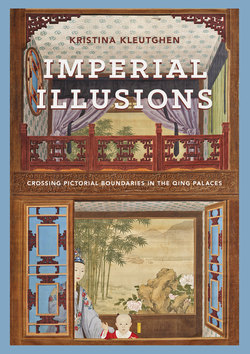Читать книгу Imperial Illusions - Kristina Kleutghen - Страница 38
На сайте Литреса книга снята с продажи.
Оглавлениеbetween seemingly real spaces and flat paintings, created by breaking up one painting style with another, are found in a number of Dunhuang’s Tang caves, demonstrating that these visual formats convincingly presented a divine space contiguous with the viewer’s own to firmly place the viewer in the presence of the Buddha and thereby offer unmediated experience of the divine. The supernatural beings depicted in the imported convex-and-concave representational style and the illusionistic spaces they occupied facilitated the viewer’s visual entry across the boundary of the wall into this other world, which was now part of the viewer’s own world because it seemingly existed parallel to the viewer’s line of sight (rather than perpendicular to it as the two-dimensional landscapes did). The size of the surfaces on which these images were painted further supported the potential for visual illusion: walls and ceilings, surfaces significantly larger than the viewer, completely engulfed his or her visual field. When deployed together with pictorial techniques that created the effects of mass and volume, the combined wall- and ceiling-painting programs in the Mogao caves often depicted complete alternate worlds in which the viewer could fully immerse him- or herself.
By the eighth century, when this painting was produced, pictorial illusionism had become common for Buddhist murals, as had the understanding of an illusionistically painted wall as a porous boundary between human and other worlds. Mural connoisseur Duan Chengshi (c. 803–63) noted a number of examples in the Buddhist monasteries of the Tang capital at Chang’an, and remarked extensively upon the generally magical qualities of wall paintings and their tendency to create supernatural experiences for their viewers.12 Duan recounted one story of viewing a mural in which an associate critiqued its lack of “evocative resonance” (yiqu) relative to its “modeling force” (tishi).13 The man then shocked his colleagues by stepping into the painting and disappearing, and returned a while later saying that he only had time to improve only one portrait, which indeed now wore a different, more smiling expression. This boundary-crossing individual was only a connoisseur and amateur artist; in contrast, it was the professional muralist who was most able to create a magical wall painting that permitted access between worlds. Even when murals were produced with an emphasis on line and painting surface rather than on modeling and spatial recession, the elements of the wall and the artist were consistent features of the animating magic of the painting.
The majority of such anecdotes surround the most famous professional Chinese muralist, Wu Daozi (also known as Wu Daoxuan, act. c. 710–60), and the vivifying power of his swirling style of ink lines, which survives only in textual descriptions.14 Recording Wu as a painter of the “Inspired Class, Top Grade,” the art historian Zhang Yanyuan (c. 815–77) commented that portable formats on silk were insufficient for him, and that only walls were spacious enough for his ideas. The famous poet Du Fu (712–70) further described his contemporary’s paintings as shaking the palace walls and even rotating the earth. In all cases, observers associated the combination of Wu’s abilities and specialization with supernatural qualities. Wu’s Buddhist hell cycles so terrified the capital’s butchers
